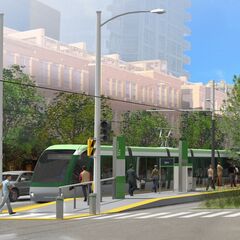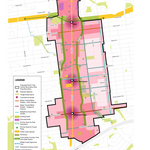The word 'Alstom' may start with an 'A', but it's definitely part of Metrolinx's 'Plan B' in its ongoing dispute with transit car manufacturer, Bombardier. Last week, the regional transportation agency announced it has entered into an agreement with Alstom, a French company, to build 17 Citadis Spirit light rail trains that will carry passengers along the future Finch West LRT line. It has also named Alstom as an alternative supplier of 44 light rail vehicles for the Crosstown LRT project.
 Eglinton Crosstown light rail transit line, image, Metrolinx
Eglinton Crosstown light rail transit line, image, Metrolinx
Last Friday, Ontario's Minister of Transportation, Stephen Del Duca and Metrolinx chief executive officer John Jensen dropped by the construction site for the future Laird Station on the Crosstown line. They told reporters, "[We're] taking a major step forward to ensure that the Crosstown LRT opens on time, and that our other LRT projects are on track. We are making great progress on the Crosstown and are well on our way to launching this outstanding new service as scheduled in 2021. Now, we are pleased to be able to say we have certainty that there will be trains to run on this line."
In 2010, Metrolinx signed a $770 million contract with Bombardier to produce 182 sets for the Crosstown and other light rail transit projects in the Greater Toronto and Hamilton Area. It ordered 76 Flexity Freedom cars for Eglinton and 23 for Finch. (The Freedom cars are wider versions of the Flexity Outlook streetcars that Bombardier is providing for the TTC. They are also capable of faster speeds.) Under the terms of the contract, Metrolinx would start delivering the vehicles in 2018.
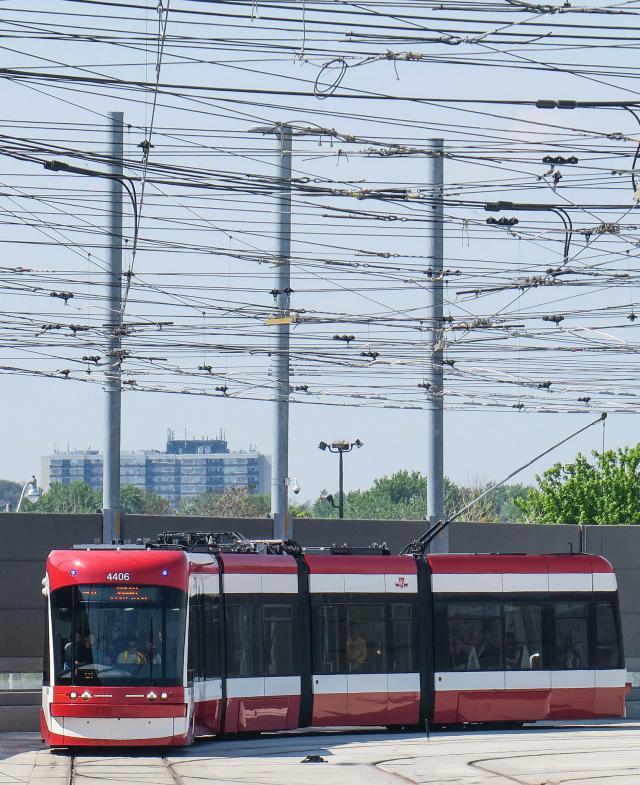 TTC Flexity Outlook car at Leslie Barns, image by BruceK via Flickr
TTC Flexity Outlook car at Leslie Barns, image by BruceK via Flickr
Since then, however, Metrolinx has been losing confidence in the iconic Canadian company. It claims that Bombardier hasn't been able to deliver a prototype of the cars that it needs for the Crosstown service, which was a key part of its contract. That worries Metrolinx officials who fear that Bombardier won't be able to supply enough of the cars in time for the line to open on schedule.
Last fall, Metrolinx issued a formal legal notice that it intended to end its Bombardier contract. Then this spring, in turn, Bombardier went to court to get an injunction, preventing Metrolinx from getting out of the deal. Bombardier won its case.
According to Minister Del Duca, "We are going through a dispute resolution process with Bombardier, but that could take 8-12 months, and we can’t wait that long to determine whether Bombardier will be able to deliver. We are hopeful that Bombardier can get its program on track, however, the steps we are taking give us a safety net if it turns out Bombardier is unable to fulfill its contract.
For its part, the manufacturer claims, "Bombardier is ready, able, and willing to deliver these vehicles to the people of Toronto on time. As the Minister and Metrolinx are well aware, these vehicles can be ready ahead of schedule and well before a single track has even been laid on the Crosstown. In fact, the Metrolinx pilot vehicle is ready, undergoing qualification testing, and Bombardier is right now producing vehicles for the Region of Waterloo that are identical to those that will be used on the Crosstown. All 14 of those vehicles will be delivered to Waterloo by the end of this year."
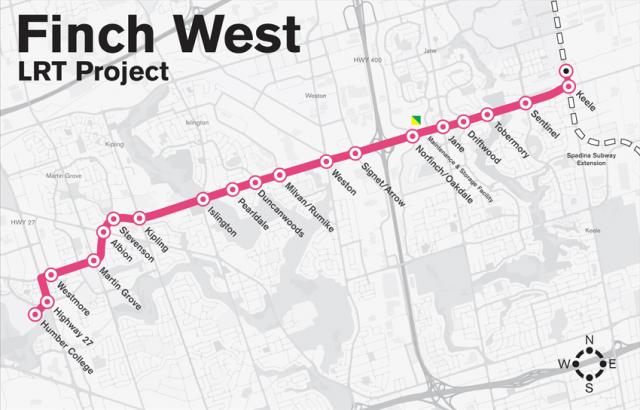 Finch West light rail transit line, image, Metrolinx
Finch West light rail transit line, image, Metrolinx
Metrolinx worked with Infrastructure Ontario and used an "alternate procurement process" to identify a consortium to "finance, build and manage" the Crosstown project. Under this process, the contractors can penalize Metrolinx if it can't provide vehicles to operate the line after construction has ended. Metrolinx says this penalty amounts to as much as $500,000 per day. When it developed a similar request for proposals for the Finch line, it signaled its dissatisfaction with Bombardier, by including a qualification that bidding proponents also supply vehicles.
Metrolinx says that if Bombardier successfully holds up its end of the deal and delivers the Crosstown cars on time, it will use the 44 extra Alstom trains on the Hurontario LRT project in Mississauga and Brampton (and probably other similar projects still on the drawing boards.)
So, who is Alstom? The multi-national French company manufactures signalling systems, railway locomotives—including high-speed trains, suburban, regional and metro trains—and light-rail transit vehicles and trams. It has provided its Citadis trams for transit systems around the world, in Bordeaux, Grenoble, Lyon, Montpellier, Rouen, Orléans, the Paris area, Nottingham, Algiers, Oran, Constantine, Barcelona, Dubai, Dublin, Istanbul, Gdańsk, Katowice, Adelaide, Melbourne, Jerusalem, Rabat, Casablanca, Tunis, Rotterdam, and Rio de Janeiro.
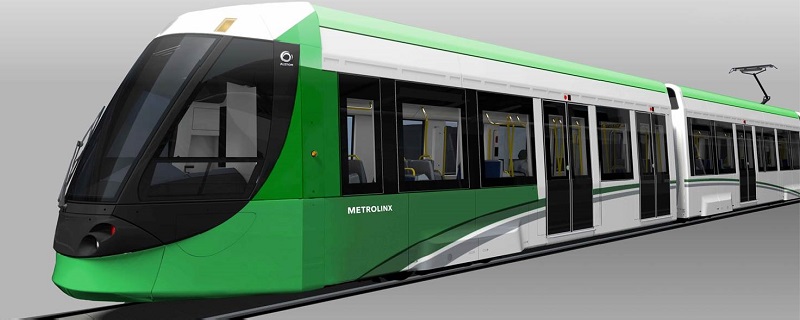 A mock-up of a Citadis Spirit car in Metrolinx livery, image, Alstom
A mock-up of a Citadis Spirit car in Metrolinx livery, image, Alstom
Until this week, it had just one contract in North America--for Ottawa's Confederation line. It's assembling the parts for the 34 Ottawa cars in Hornell, New York (southeast of Buffalo), but final assembly takes place in Ottawa, near the St. Laurent garage for OC Transpo, the local transit service. Alstom may use a similar process to fulfill its Metrolinx contract, perhaps with a plant in the Greater Toronto area. (Bombardier makes its vehicles at two Ontario facilities in Thunder Bay and Kingston.)
At 48 metres (157 feet), the Citadis Spirit cars are longer than Bombardier's Flexity Freeedom vehicles, which are 31 metres (101 feet) long. They hold more passengers, too; 292, instead of the Flexity capacity of 164. The longer cars may also require Metrolinx and the consortium of contractors building the line to adjust infrastructure on the line. Metrolinx explains, "the Eglinton Crosstown LRT infrastructure will require redesign to accommodate both vehicles. The costs of this variance, enabling the system to accommodate both types of vehicles, is under negotiation with Crosslinx Transit Solutions [the contractors]".
According to a Metrolinx fact sheet, the total cost of the 61 Alstom vehicles is $528.8 M, while the cost of the 99 Bombardier cars is $528.8 M. That works out to a cost of $8.67 M for each Alstom vehicle and $5.34 M for Bombardier. Each Alstom unit has seven dual doors on each side, while Bombardier offers passengers two single doors and two dual doors. Alstom includes room for four wheelchairs, but Bombardier allocates just two spaces. Alstom Citadis vehicles can attain a top speed of 100 kilometres per hour (60 miles per hour), while Bombardier Flexitys reach 80 kilometres per hour (50 miles per hour). Both models can operate in train sets with multiple cars.
Fortunately for both companies, Metrolinx probably needs a lot of light rail transit vehicles. It plans to open the Crosstown light rail line in 2021, but it's already started preliminary work on the Finch LRT and expects to name a successful supplier this year. It has scheduled the 11-kilometre (seven-mile), 19-stop line also to open in 2021. Metrolinx intends to start building the 20-kilometre (12-mile), 23-stop Hurontario line in 2018, with the first cars rolling into service in 2023.
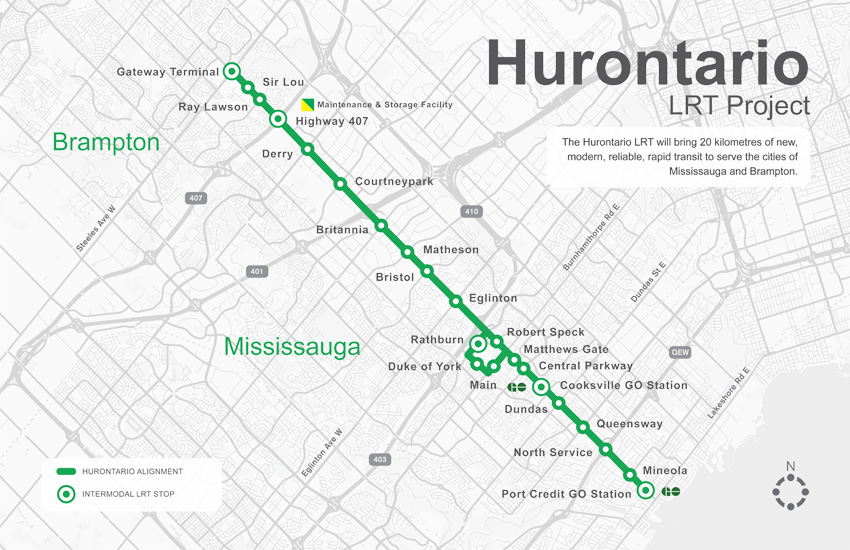 Hurontario light rail transit line, image, Metrolinx
Hurontario light rail transit line, image, Metrolinx
Still ahead is an LRT in Hamilton with 17 stops along 13.4 kilometres (8.4 miles). Not yet funded, but still in the planning stages, are extensions of the Crosstown line west to Toronto Pearson International Airport and east to the University of Toronto's Scarborough campus. Finally, an LRT on Sheppard Avenue East between Don Mills and U of T Scarborough is still on the books.
So, to review: Alstom, with an 'A', is part of Plan B, while Bombardier, with a 'B', is still part of Plan A... no wonder everyone gets confused and frustrated with transit projects in Toronto!
* * *
What do you think of the vehicle choices? You can share your thoughts by leaving a comment at the bottom of this page, or by joining in the ongoing discussion on our Forum.

 5.5K
5.5K 



